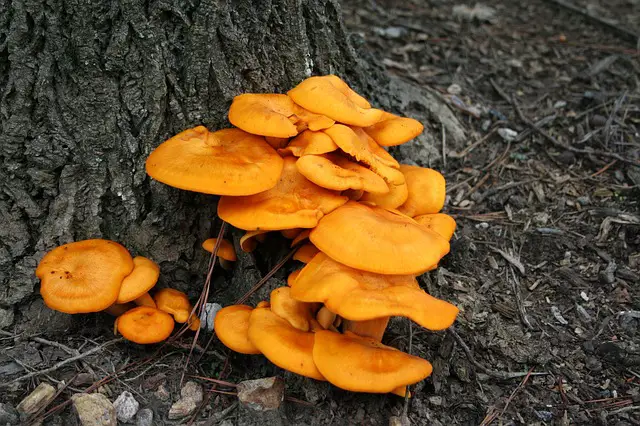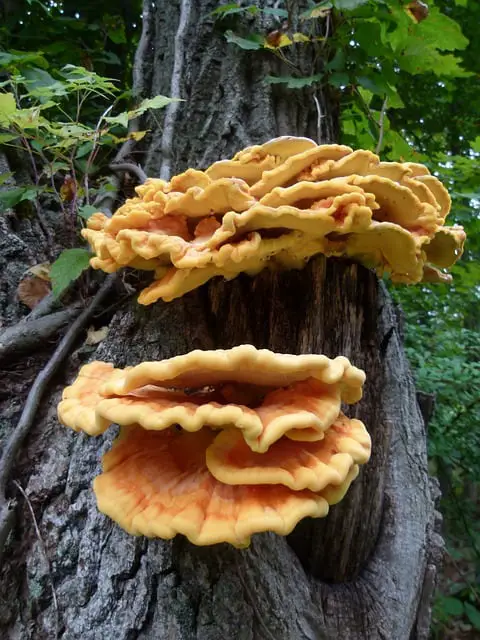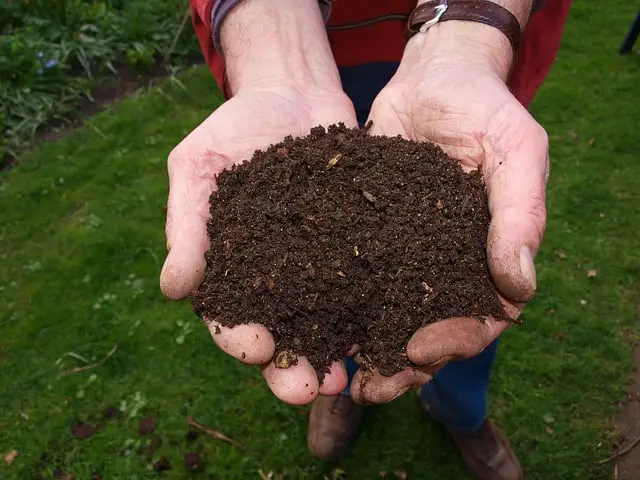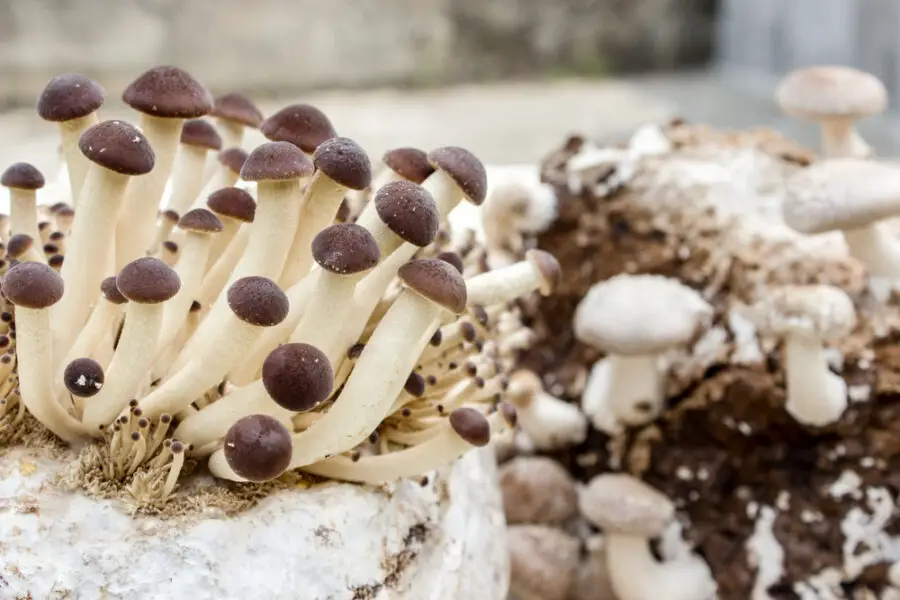There are several species of mushrooms that are yellow. But of the 10 most popular, three of them are poisonous. These are Flowerpot Parasols, Yellow Patches and Jack O’ Lantern mushrooms. The most dangerous of the three are Jack O’ Lanterns and Yellow Patches while Flowerpot Parasols have mild to severe toxicity.
What Are Flowerpot Parasols?
Leucocoprinus birnbaumii, or Flowerpot Parasols, grow in greenhouses and flowerpots. However, you can find them naturally in tropical and subtropical climates. They are a bright yet pale sulfur-like yellow and either appear as a cluster or as an individual fungus.
While they don’t hurt nearby plants or steal nutrients, they are toxic for humans and animals to eat. But, they’re beneficial for their environment because they love rotting organic matter which boosts soil’s carbon, nitrogen and other minerals.
What Are Yellow Patches?
Found on the forest floors of eastern North America, Yellow Patches are highly toxic. Scientifically called Amanita flavoconia, it has a yellow-orange cap and warts or patches and a whitish orangey stem. It’s part of the most poisonous mushroom family in the world. These can be deadly if ingested.
The good news is that these particular mushrooms are easy to identify and locate. Often mistaken for its cousin Amanita frostiana, they are both poisonous and inedible. Younger Yellow Patches often have a surface appearing as chrome-yellow spots, hence the name.
When the mushroom first emerges, the cap appears egg-shaped. However, during maturity, the cap curves and eventually flattens. Under the cap, the gills are white or yellow and close together, with a yellowish veil partially covering the gills.
What Are Jack O’ Lantern Mushrooms?
Jack O’ Lantern mushrooms, also called Omphalotus olearius and Omphalotus illudens, is a late-summer mushroom found throughout North America and Europe. They grow in large clusters on decaying stumps, roots or at the base of some trees.
These have a yellowish orange hue with sharp, non-forking gills. Although they smell nice with a gorgeous appearance, these are extremely poisonous. What’s more, they look like the edible and delicious Chanterelle mushroom.
Their name comes from how they usually appear during Halloween and from their bioluminescent properties. They contain an enzyme, Luciferase, which allows Jack O’ Lanterns to glow in the dark. It emits a greenish-blue illumination in low-light conditions.


Which Yellow Mushrooms Aren’t Poisonous?
Not all yellow mushrooms are poisonous with some sought after for their nutritional and medicinal values. Although there are many varieties worldwide, there are seven that are the most popular and common to find.
Chicken of the Woods
Often found on oak trees, Laetiporus sulphureus is a polypore fungus native to Europe and North America. Chicken of the Woods received its name due to how it tastes like chicken. It lives on rotting or dead organic matter or appears as a parasite on living trees.
They’re very large and have a sulfuric yellowish orange color and fan-shaped shelf structure. Although the young versions of this are edible when cooked, they can be toxic if found on growing on certain trees. They have very miniscule pores on the interior side of the caps rather than gills or ridges.
Golden Chanterelles
Located in forests from Europe to the Mediterranean basin, Golden Chanterelles are some of the most edible, tasting something like ripened apricots. They form connections with plant roots, which help plants accumulate nutrients in the soil.
Cantharellus cibarius, or Golden Chanterelle, is yellow with a smooth cap that has curved edges. They also have forked ridges traveling down the stem. You can see these in summer and autumn, depending on the type. However, Jack O’ Lanterns and False Chanterelles have similar characteristics; both are poisonous.
Golden Ear
Tremella aurantia, or Golden Ear, are mushrooms named after their appearance. They’re native to various areas around Europe and North America. It is parasitic to other fungi with an orangey yellow curl. Golden Ears appear in late summer and early fall after heavy rains.
They become very orange with a hard crust when there isn’t enough moisture. These are technically non-toxic but no one knows if they are safe enough for eating.
Golden Oysters
These very popular and edible mushrooms are native to northern China, eastern Russia and Japan. They look like oysters, ergo the name. Today, many countries cultivate them for their amazing constituents for use in cuisine and healing.
Golden Oysters, or Pleurotus citrinopileatus, feast on decaying hardwoods and develop in clusters on fallen tree trunks. They’re a bright golden yellow and easily seen. While these aren’t poisonous, they can look similar to other mushrooms, like the western Jack O’ Lantern, that definitely are.
Golden Spindle
Found in Europe, North America and Asia, Clavulinopsis fusiformis, or Golden Spindle, is a yellow-coral spindle-shaped fairy club. They look something out of a fairytale. They feed on decaying wood in areas covered in grass and moss.
They’re slim, bright yellow and elongated cylinders that grow in dense clusters. These are non-toxic, but whether they’re edible or not is up to debate.
Golden Waxcap
Golden Waxcaps, or Hygrocybe chlorophana, are a tiny yellow species of mushroom seen in woodland and grassland regions throughout North America and Europe. The cap is always moist and looks covered in wax with broad, spaced gills on the underside.
These grow in small groups in autumn and don’t often exceed 1½ inches. Golden Waxcaps are very safe to handle, but not necessarily to most delicious to eat.
Witch’s Butter
An usual type of mushroom, Witch’s Butter, or Tremella mesenterica, has an irregular shaped body that comprises a gelatinous yellow-orange mass with a lobed surface. It takes on a slimy or oily texture when moistened. Under dry conditions, they look dark red or orange.
These have a wide distribution, found in the temperate and tropical forests of on many continents. They grow on or are parasitic to dead wood and other wood-decomposing fungi. Witch’s Butter grows all year, most often after it rains and throughout wet seasons. Although non-toxic and edible, it’s tasteless.


